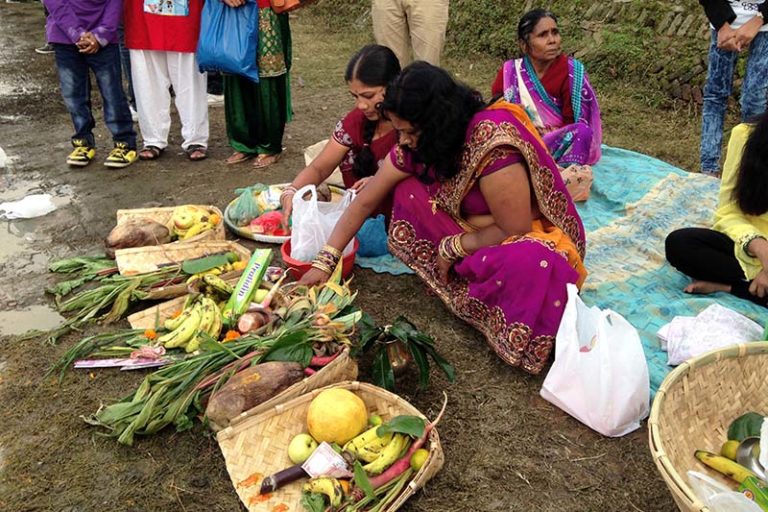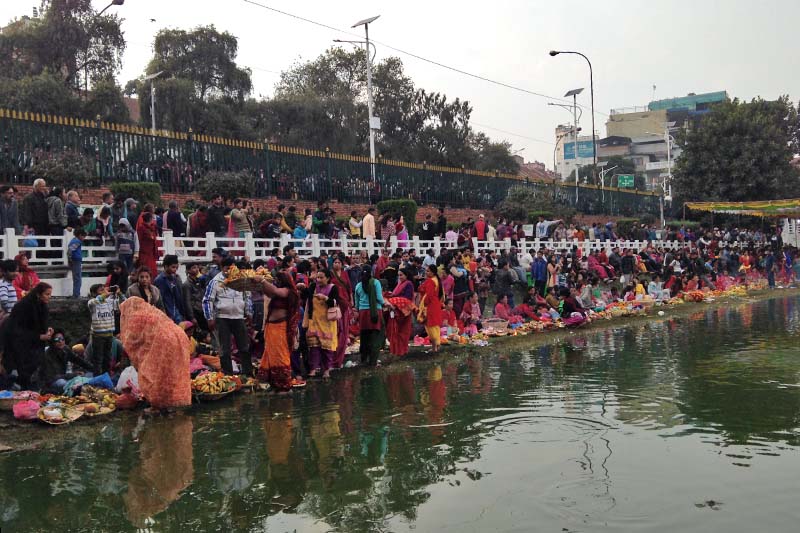Kathmandu, November 6, 2016:Â Once limited to the people from the Mithila community of Nepal, Chhath festival these days is celebrated by people from different communities across the nation. Its popularity is rising even in Capital in the recent years, thanks to unique yet varied charming aspects associated with this festival.
Every year during Chhath, people worship the Sun, thanking it for sustaining life on the Earth. Prayers and offerings are made to the rising and the setting Sun wishing for prosperity, happiness and long life of the family members. But Chhath is more than that — it is also about following strict fasting regimen, savouring various delicacies while celebrating nature and women.
Food varieties

It is not a festival if you do no get to savour varieties of delicacies. And Chhath is not an exception! Thekuwa for instance is one of the important items prepared during this festival.
“There are different ways to make Thekuwa,†explains 45-year-old Pramila Sardar, a permanent resident of Fattepur, Saptari and currently residing in Jadibuti.
“One can mix flour with ghee, and sprinkle some water in the mixture. Take a small portion from the mixture, and give it a desired shape. This should be then deep fried in ghee or oil,†Sardar shares her recipe for preparing Thekuwa.
To create the mixture, one can also mix water, flour and sakhhar. Another way is to mix flour and water together as per Sardar.
“If you want to make Thekuwa tastier with aromatic smell, then add dry fruits such as cardamom, coconut, cashew, dates, raisin in the mixture,†explains Rukmini Devi Gupta, a 42-year-old resident of Sarlahi, currently residing in Kupondole.
Besides Thekuwa, another important item required during Chhath is Bhusuwa — a rice flour ball. Gupta explains the procedure to prepare this dish, “First we wash rice, heat it, grind it and mix it with the melted molasses. And then make small balls out of the mixture.â€
Khajuri is also essential during Chhath. And all these dishes are offered to the Sun God during the four-day-long festival that started on November 4 this year.
These food items are favourite among children and five-year-old Sushmita Thakur from Jadibuti is one of them. “There is so much fun during this festival. Songs and dances along with Thekuwa and Bhusuwa come to my mind when I think of Chhath. The food items are so delicious that I always look forward to this festival,†she shares.
Nature conservation, social harmony
Having fun while savouring various food varieties, and wishing for the well-being of oneself and family are important aspects of Chhath. But then this festival is also about nature conservation and social harmony.
During Chhath the Sun is worshipped and water resources are cleaned. As the sun and water are both elements of nature, worshipping the Sun and cleaning water resources add to the act of nature conservation. “Moreover, the festival is incomplete without water resources,†culture critic Ram Dayal Rakesh informs.
Cultural academician Jagman Gurung adds, “The tradition of cleaning the water resources by Mithila people is similar to that of Newars of Kathmandu cleaning wells. This also shows how the culture of two groups are similar.â€
The festival Chhath also attempts to end caste-based discrimination, bringing social harmony among people of different castes. “People of so-called lower cast are not allowed to touch water resources during other time of the year. But during Chhath, all people irrespective of their castes take bath and worship on the same pond. The festival maintains equity among the people,†Gurung elucidates.
Rakesh calls this gesture “a symbol of communal harmonyâ€.
Role of women

It is women, especially the married ones, who have important role to play during Chhath. They are the ones who fast, offer prayers to the Sun and also cook during the festival. It means, the women who are living under the veils in the Tarai have more dominant roles in the festival as per Rakesh. He elaborates, “The items necessary for the puja are usually purchased by male members from the market. Women enjoy, sing songs, dance, fast and rejuvenate themselves.â€
“Despite the strict fasting — we do not drink a single drop of water for the entire day — we prepare food varieties, work in groups and enjoy,†Gupta shares happily.
And sharing about the current scenario of Chhath celebrations in Janakpur, Muktinath Shah, Associate Professor of Chemistry at RR Campus, Janakpur, states, “Men are busy in gathering all necessary items required for celebrations while the women are busy in decoration, cooking among others.â€
Since both men and women have their own share of responsibilities, Shah prefers to call it a “festival celebrated in togetherness and unity by allâ€.
Increased popularity
Meena Karki, 35, from Baneshwor has learned the rituals of Chhath through her neighbour. “When I saw my neighbour Ramila Thakur celebrating this festival I too wanted to do it,†she shares adding, “I feel Chhath is similar to our festival Teej in many aspects. And there is no harm in fasting and worshipping.†This is her third year celebrating the festival.
Like Karki, many people in Capital have begun to celebrate Chhath, though it was limited mostly to the Tarai region some years back.
And migration could be one of the reasons behind this as per Gurung. “People from different places are living in the same house in Kathmandu. When one person celebrates his/her festival, the others inquire about it. It is very natural and that is why people here have been interested in celebrating the festival,†Gurung elaborates.
Despite the increasing interest of people in the festival of Chhath, some feel that the festival does not hold the same charm like before.
“There used to be great fun celebrating the festival. We used to wash wheat in group, sing songs and grind them in dhiki (a traditional grinding equipment). Though there aren’t such groups here and nor are thedhikis available we go to the mills to grind wheat,†shares Gupta.
Sardar too feels that the celebration in the City isn’t as fun filled as it used to be in village. “We used to spend the night near the pond with friends and neighbours back in the village but here we can’t do so as we don’t know people here,†Sardar adds.
No celebrations at Ranipokhari

Swarms of people queuing up to enter the Ranipokhari premises used to be a common scene during Chhath in the previous years. The pond used to be lit and decorated, giving a perfect feel and ambience for the festival. However, this year this won’t happen. You won’t be able to see Ranipokhari with decorations. And there will be no celebrations here as the pond is currently under construction.
“This year Ranipokhari won’t be opened for the public for Chhath celebrations because the reconstruction of the pond is going on. Department of Archaeology is doing the reconstruction of the Balgopaleswhor Temple while Kathmandu Metropolitan City (KMC) Office is constructing the footpaths, garden, chairs and others,†informed Gyanendra Karki, Spokesperson of KMC.
If you are looking for the alternatives of Ranipokhari, then Teku Dobhan could be one destination. “As an alternative to Ranipokhari, we have chosen Teku Dobhan where people can celebrate the festival,†Karki added.
By Sabitri Dhakal







